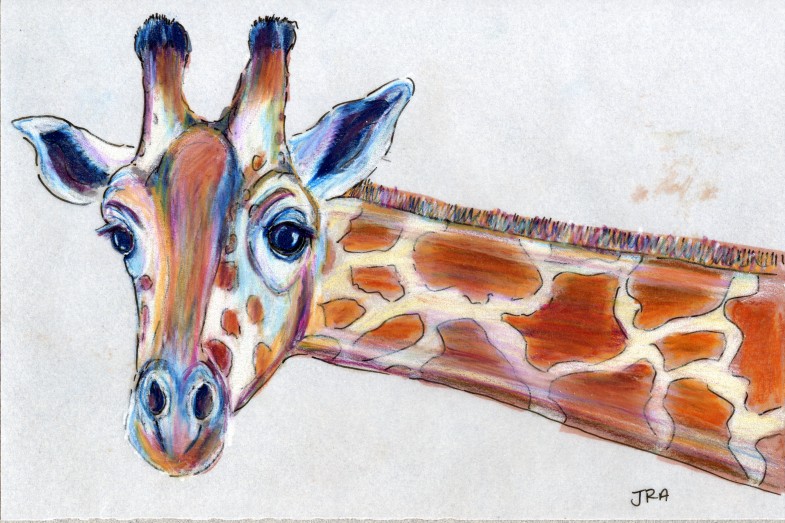Darwin Days: Giraffe (Giraffa camelopardalis)
Tonight, we conclude our celebration of Charles Darwin’s 200th birthday with one last look at a mammal he wrote about in The Origin of Species.
Although Darwin’s work is widely available for free online (see The Complete Work of Charles Darwin Online, and you’re probably all set), I still find it easier and more satisfying to thumb through an actual book. It’s kind of like rewinding a cassette tape versus placing a needle on a record. For me, anyway. So I bought a Penguin edition of Origin. There were three different printings to choose from at my bookstore, and I picked the middle one, price-wise, which seemed to have decent paper. Turns out it’s a reprint of the first edition, and Darwin produced six editions total, each quite different from the previous. All this is to say that in the sixth edition, Darwin added a second chapter dealing with objections to his theory. In that chapter, he discusses the giraffe in great detail, discussing how and why it might be advantageous for a “nascent giraffe” to evolve a long, long neck.
It seems that the giraffe is still throwing people for a loop. When I was researching giraffe photos online for reference, I found one posted on Flickr that had a long, not overly polite discussion in the comments section about whether or not it was possible for a giraffe’s neck to evolve, or whether the very fact of the giraffe’s long neck was proof of the creation of the giraffe as a whole being, immutable and perfect. To me, it seems a textbook example of natural selection: the protogiraffes with the longest necks were able to eat more than the others. They lived longer because they ate longer. They reproduced more because they lived longer. More giraffes were born with long necks. And so on. But people still have problems with it because the giraffe seems unique, because it requires special structural adaptations in order to operate with such a long neck, or maybe because it looks like something someone like Dr. Seuss would have had to think up.
The giraffe reference I particularly like in Origin, though, is in my first-edition reproduction. After discussing the problem of the evolution of organs of seeming perfection (like the eye), Darwin addresses the problem of the evolution of “organs of little apparent importance.” In his charmingly open and self-effacing way, he writes, “I have sometimes felt much difficulty in understanding the origin of simple parts, of which the importance does not seem sufficient to cause the preservation of successively varying individuals.” Darwin goes on to point out that we shouldn’t be so arrogant as to presume we know what’s important and what’s not. And the example he uses is the giraffe’s tail:
“The tail of the giraffe looks like an artificially constructed fly-flapper; and it seems at first incredible that this could have been adapted for its present purpose by successive slight modifications, each better and better, for so trifling an object as driving away flies; yet we should pause before being too positive even in this case, for we know that the distribution and existence of cattle and other animals in South America absolutely depends on their power of resisting the attacks of insects: so that individuals which could by any means defend themselves from these small enemies, would be able to range into new pastures and thus gain a great advantage. It is not that the larger quadrupeds are actually destroyed (except in some rare cases) by the flies, but they are incessantly harassed and their strength reduced, so that they are more subject to disease, or not so well enabled in a coming dearth to search for food, or to escape from beasts of prey.”
First of all, don’t you love that 19th-century sentence structure, with endless commas, colons, semicolons, and then more commas? I love it. What Darwin is saying here* is that a fly-swatter is not as trivial as it seems. Fighting off flies saps a person’s energy, and so it makes sense that the best fly-flighters would have a reproductive advantage. I imagine this is why giraffes have such lovely eyelashes, too.
My husband Ted has a theory that sexual selection could play a part here (see my lion post of a couple days ago). In his theory, female giraffes would be more attracted to those male giraffes who coolly switched their tails, rather than those who itched and jumped because flies were crawling all over them. It makes sense to me.
*I should note that my mammalogy is completely self taught. Two of my worst teachers ever were my two biology teachers (7th grade and 9th grade). What knowledge I have of science is from my dad (a geologist and painter) and my own curiosity and love of animals. So if I’m telling you really, really obvious things about evolution, I apologize. I’m just learning it all myself.


Darren has a nice post on the various evolutionary scenarios proposed for giraffe necks.
Wow! Thanks for that, Neil. That’s very interesting. So it looks like the simple answer is PROBABLY mostly correct.
On a completely different note, I would like to stay at the Giraffe Manor, a hotel in Kenya where giraffes are constantly sticking their heads (and necks) in the windows.